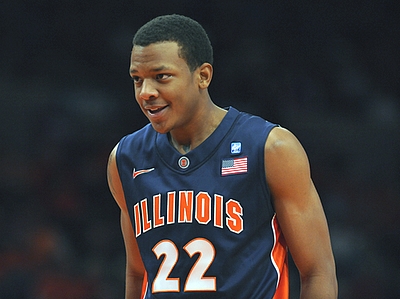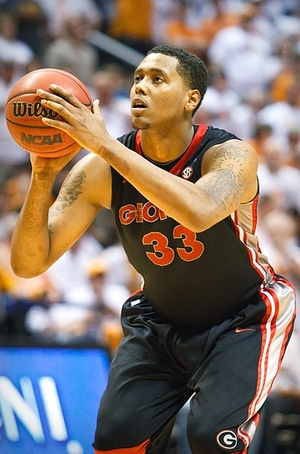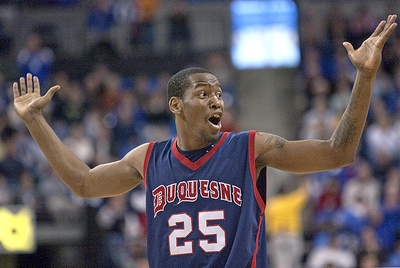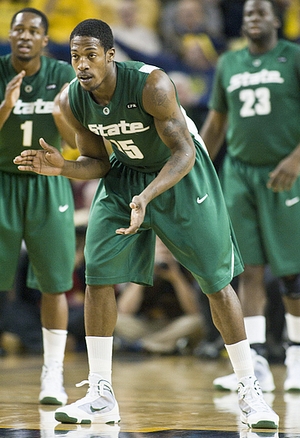7.8 Points, 5.3 Rebounds, 1.9 Assists, 1.7 Turnovers, 51% FG, 59% FT, 20% 3P

Matt Williams
A consensus top-30 recruit and McDonald's All-American last season, Jereme Richmond has had an inconsistent rookie campaign littered with moments of brilliance, including an 18-point 10-rebound outing against Ohio State in late January. After dealing with some personal issues that caused him to miss a few practices and sparked rumors of a mid-season transfer, Richmond has since reaffirmed commitment to the Illinois program despite its difficulties in Big Ten play.
Though Richmond hasn't had a tremendously productive season, nor does he possess a reputation for fundamentally sound play offensively, he is amongst the most impressive physical specimens in NCAA basketball and a legitimate NBA prospect because of it. Tremendously long and athletic, Richmond has great speed in the open floor, explosiveness, and a frame that has room for additional muscle. He's an emotional player, who can get his team going with a highlight reel play, but needs to hone his basketball IQ and skill-level.
Richmond's potential is most notable on the defensive end, where he's been very good for stretches this season despite his inexperience. He has struggled at times against more aggressive, experienced slashers and savvy pick and roll-oriented scorers, but he's shown the tools to defend the perimeter effectively and could emerge as a high-level defender with additional coaching and strength.
Richmond's ability to defend the perimeter is important because at just 6'6, he has spent most of his time playing a power forward-type role offensively for the Illini in the high post to allow Mike Davis and Mike Tisdale to using their shooting ability stepping out on the baseline. Despite showing a raw versatility and midrange game that give him intriguing upside, most of his offensive possessions come from basic hustle plays and post-ups against smaller guards off of switches. An extremely effective finisher and rebounder thanks to his leaping ability, Richmond flashes a hook shot that could be an asset to him against smaller players if he continues to develop it down the road.
Richmond's knack for making plays at the rim is a big part of his contributions in the college game, but the development of his perimeter scoring arsenal will dictate his long-term success. He shows soft touch when shooting inside and good follow through on occasion, but the rhythm and release point of his jumper remain inconsistent and will limit his ability to play the wing full time in the NBA early on. He's made just two 3-pointers in 27 games thus far this season.
The 18 year old forward also has plenty of room to grow as a slasher. He has the first-step and rangy stride that could make him a handful to keep out of the lane, but lacks the ball-handling ability and strength to confidently get to the rack. Very raw on the whole, Richmond is the type of player who will coast for long stretches before making one great play seemingly every game to remind you of how good he might be down the road.
If Richmond can develop the capacity to knock down catch and shoot jumpers from the outside, play low-mistake basketball and emerge as a lock-down defender, he has the potential to fill a highly coveted role in the NBA. With Mike Tisdale, Demetri McCamey, and Mike Davis all graduating, Richmond could be in position to have a breakout year in 2012, but his physical tools make him a potential first round pick as soon as this summer if he feels the urge to make the leap early. Something of a blank slate at this point, Richmond has plenty of improvements to make and plenty of time to make them whether it is on a NBA bench or in Champaign.
Trey Thompkins, 6-9, Junior, Power Forward, Georgia
16 points, 7.7 rebounds, 1.7 assists, 2.6 turnovers, 1.3 steals, 1.8 blocks, 45% FG, 70% FT, 24%3P

Walker Beeken
Trey Thompkins came into the 2010-2011 season as a player who many thought will make the jump to being one of the best big men in country, following a solid sophomore season where he showed a versatile and productive skill-set for a player his size. Unfortunately for Thompkins, while he has improved his game in certain areas, he's taken steps backwards in others, and hasn't been as productive overall as he was last season.
From a physical standpoint, Thompkins has nice size for an NBA power forward prospect at 6'9 with broad shoulders, but just-average athleticism, some of which can likely be attributed to a lack of conditioning. His body isn't as toned as scouts would like to see, and his quickness and explosiveness leave something to be desired. In fairness to Thompkins, he did begin the season with an ankle sprain that caused him to miss some practice time as well as the first three games of the season, but we noted last year that maximizing his athletic ability would be a key to for his draft stock, and he hasn't made the necessary strides in that area.
Much of Thompkins' struggles this season can be traced to his extremely poor shooting. After shooting a solid 38% from the 3-point line and 39% overall on jump shots as a sophomore, he has regressed dramatically, connecting on only 24% of his threes and 23% of his jumpers this season. For a player who lacks the ideal physical tools and toughness around the basket, it's discouraging to see these dips in his shooting numbers, as his ability to knock down open shots was a big part of what made him so intriguing as a prospect.
It's difficult to say what the cause is for his drastic regression as a shooter, as he shot the ball well his first two seasons, and he's taking fairly close to the same amount of shots from similar spots on the floor. Even though he probably is a better shooter than what we've seen from him this season, this should be a sign for him that he needs to be more selective with his jump shots. He's the focus of most teams' defenses at the college level, though, and would probably be more of a complimentary piece in the NBA, where he'd get more open looks. He's shown before that he's capable of knocking those shots down, but his shooting woes this season aren't helping his case.
On a positive note, Thompkins has continued to become more efficient in the post, scoring an impressive 1.1 points per possession this season, up from the .9 points per possession on his post up opportunities as a sophomore. He continues to display good footwork, a high skill level, and the soft touch we saw from him before, and although he still probably relies a bit too much on his turnaround jump shot - often fading away from the basket - he does have a refined post game for a player his age, and has the potential to continue to improve and become an effective weapon on the block.
Defensively, Thompkins still has some of the issues we saw from him last year, as it's questionable whether he's always giving maximum effort, possibly partly due to conditioning issues. He's slow to get out and challenge shots, and he lacks the lateral quickness to defend some of the quicker power forwards in the NBA. In the paint, Thompkins shows good instincts and is a solid shot-blocker, but his lack of consistent intensity and toughness will be even a bigger obstacle at the NBA level, where he'll face more players who are more physically gifted than he is. His rebounding has dropped off once again this season, for the third straight year, which is not a good sign all things considered.
Overall, Thompkins still has some intriguing qualities with his high skill level for a big man and his potential as a scorer on the block. His shooting woes have been disappointing though, and he'll need to prove through the end of the season or in workouts that he's a much better shooter than what we've seen from his so far this season. Big men with his feel, touch, and skill level aren't easy to come by, but the questions about his motor and consistency will have to be looked into deeper by teams to find out whether or not he's a guy who will ever reach his full potential.
Damian Saunders, 6-7, Senior, SF/PF, Duquesne
12.6 points, 7.7 rebounds, 2.6 assists, 1.7 turnovers, 2.3 steals, 2.7 blocks, 48% FG, 52% FT, 35% 3P

Derek Bodner
Combining a terrific defensive physical profile with consistent effort, Damian Saunders is one of the more intriguing players in this draft from a pure defensive standpoint. The reigning A-10 Defensive Player of the Year, Saunders needs to show a more consistent jump shot and better decision making on the offensive end to find a position in the NBA.
For Saunders, his senior year has been a mixed bag in that regard. Despite the transfer of Melquan Bolding, Saunders' usage offensively has declined, from 21% of the team's possessions last year to 16.4% this year, taking a back seat to fellow senior Bill Clark. Saunders' averages have fallen accordingly, down to 14.3 points per 40 minutes pace adjusted from 15.2 last year.
That being said, when projecting Saunders' game to the next level key areas have shown incremental improvements, even if he hasn't been more productive as a whole offensively. He's shooting significantly more jump shots this year than last, and at a much more efficient clip, making a respectable 35.2% from the collegiate three point line this year compared to 18.9% last year. On jumpers as a whole, his 1.080 points per shot is a drastic improvement over last year's 0.480 number. We're still not talking about a huge sample size (50 in 25 games), but the improvement is encouraging.
That's not to say his jump shot is picture perfect. There's still a considerable amount of wasted motion, which results in quite a bit of inconsistency. There's still a lot of work to do to improve in that regard, and it's going to be a question -- if not the main question -- about his game going forward.
The majority of the remaining portion of Saunders' half-court offense comes in the form of cuts and offensive rebounds, as he has a constant motor and uses his length well in both of those areas to finish around the hoop. He's not likely to be a major half-court offensive contributor, and has been very inefficient in isolation and post-up situations during the limited sample amount he has attempted.
Heavily favoring his left hand and appearing out of control at times, Saunders will have to improve his ball-handling skills significantly to use this part of his game with any regularity. His long strides and solid first step hints that he may have some untapped potential attacking the basket, but to this point he's hampered by his lack of an off hand and struggling to finish through contact. He has, however, done a much better job of drawing contact and getting to the line this year, mainly through his work in transition.
Defensively is where Saunders has made a name for himself, and why he may be an intriguing prospect for a team to look at in the second round. Saunders is an extremely versatile defender, using his length and great lateral quickness to effectively defend perimeter players. He's also a very good weak-side help defender, as evidenced by his 3.1 blocks per 40 minutes pace-adjusted, particularly impressive when combined with his 2.5 steals and only 2.5 fouls.
Duquesne plays a largely (albeit not entirely) man to man defensive scheme, switching on most screens and playing a lot of full court press. This allows us to take a look at Saunders on the perimeter, and he does a very good job for a player of his size moving his feet on the perimeter and playing smaller, quicker players off switches. According to Synergy Sports Tech, opposing players are averaging only 0.588 points per shot in isolation situations when he's defending, and he's in the top 97th percentile in defending the pick and roll. For a player who projects to be primarily a perimeter player at the next level (but has been playing primarily in the post in college), the versatility he's shown on the defensive side of the ball is a great asset.
When Duquesne does go zone it's usually in a 2-3 with Saunders probing the middle or as a 3-2, with Saunders coming up to use his length to disrupt the passing lanes. Saunders can struggle at times against stronger players in the post, and adding a few more pounds of muscle could do him well. While he will likely be playing primarily at the small forward position, the ability to defend both forward spots would help when trying to get court time and make a roster.
Strength can become an issue at times on the defensive glass as well. While Saunders isn't a bad defensive rebounder for a small forward, his productivity did drop a bit on the defensive glass, falling from 6.9 defensive rebounds per 40 minutes pace adjusted last year to 5.5 this year on a poor defensive rebounding Duquesne team which features no player in the regular rotation over 6'7. He shows good effort and technique on the defensive glass, and improving his lower body strength could again go a long way towards opening up minutes for him to play power forward in a small lineup.
Saunders has the defensive tools to be a very versatile defender in the NBA, and while his overall offensive productivity may have dipped this year, his slight improvement in certain facets of the game could be key in his ability to stick to a roster. There's a lot of work still left to be done, and clearly he can't be described as anything more than an offensive project, but if a team believes his jump shot can become consistent he has the defensive potential to hear his name called on draft night.
Durrell Summers, 6-5, Shooting Guard, Senior, Michigan State
12.3 points, 4.1 rebounds, 1.5 turnovers, 40% FG, 68% FT, 36% 3PT

Joseph Treutlein
Steadily improving his production each of his four years in college, Durrell Summers is almost through his senior season, yet still boasts a very modest statline even at 29.5 minutes per game. A player who's seemed to be on the verge of breaking out many times throughout his career, Summers is still mostly the same player he was a few years ago from a skills perspective.
Having a solid season about on par with what he did as a junior, inconsistency remains the name of the game for Durrell Summers, who's had some very dramatic turns over the course of the past few months. Having a great streak early in the season where he scored double figures in twelve straight games, he's done a 180 degree turnaround of late, failing to reach double figures in six straight games, including a zero point showing in a loss to Ohio State.
A player with a highly defined role on the offensive end, that being spot-up perimeter shooting, Summers is prone to falling off the map when his shot isn't falling, as he just doesn't contribute much consistently in any other areas on this end of the floor. According to Synergy Sports Technology, an amazing 186 of Summers' 234 (79.4%) half-court shot attempts were of the jump shot variety, with him taking just 48 around the basket. Further hurting his anemic inside game is the fact that his two-point field goal percentage has plummeted to a four-year low of just 40.2% this season, and is getting to the free throw line at a career-low rate of 3.2 times per-40 minutes pace-adjusted.
Looking at Summers' jump shooting, he's a very capable shooter who does a great job moving off the ball, coming around screens, and being in good stance for a quick catch-and-shoot when the ball comes his way. He has a high and quick release along with solid overall mechanics, though a slight tendency to jump into his shot makes it tough to get off good contested looks at times.
Shooting 37% from behind the arc on 5.4 attempts per game (and posting similar efficiency numbers most of his career), Summers is a very good college shooter, but for a player who's offensive game begins and ends with his jump shot, there are questions about if he's good enough to get by in the NBA. Many notable college gunners get to make a role adjustment heading to the NBA, shifting to more catch-and-shoot and less off-the-dribble shots, but Summers already fills that role, with 151 of his 186 jumpers coming of the lower difficulty variety. Not having that projected uptick to fall back on combined with the deeper NBA three-point range will make it tough for Summers to maintain his efficiency at a good but not great 37%.
Looking at the rest of Summers' scoring game, he actually has some good tools at his disposal, namely his bouncy elevation around the basket and outstanding length, but his woefully underdeveloped ball-handling and tendency to shy from contact don't highlight those traits very well. Projecting to the next level, Summers at least will need to develop a more competent off-ball cutting game, as he has the potential to be a dynamic slasher and offensive rebounder using his tools to get to the basket within a team's offense. He also will need to show better shot-making ability around the rim, as he currently is usually intent to just throw the ball in the direction of the basket rather than focusing on getting up a good look.
Defensively is where Summers will really need to make his living if he makes it in the NBA, as he great tools for a shooting guard with his lateral quickness, length, and ability to change directions fluidly, while having the fundamentals and effort level to go along with it. He shows a good stance off the ball and does a great job using his length to pester the opposition on the ball, being a tough match up in isolations. He's prone to being taken off the dribble against explosive first steps but is excellent when he gets in stride with his man, using his length to block and contest shots in the lane well. He also shows fluid hips and sticks with quick changes of direction very well.
Looking forward, Summers will have an uphill battle to make it in the league if he continues to play the way he has recently. Another strong performance in March as he had last season could definitely help himself and potentially sway teams making late decisions. The expected relative weakness of this draft class should help him get into consideration more easily, and his shooting, physical tools, and defensive ability gives him a chance of making it as a role player. Going into a situation where he can stick to his strengths in a running, open system with an emphasis on open jumpers would be best for him, and may be critical to his chances.
































Comments